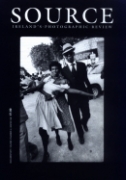No Smoke Without Fire
Book Review by Sarah Edge
Issue 10 Winter 1997
View Contents ▸
Published by: Matt's Gallery, London
ISBN: 0 907623 255
Price: £12.95
This publication immediately causes the reader some confusion, as it does not fit readily into any recognisable type of art publication. Whilst it is clearly a book of 'art' photography, it is not a catalogue. It does not document or accompany a specific exhibition of work. Nor is it a publication about the artist or his work, it offers us no information about Willie Doherty, his history or his ideas. The simplest way to describe this publication is an artwork in its own right. In some respects it operates as a kind of visual retrospective of Doherty's more recent works and includes two of his most well known installations; The Only Good One Is A Dead One (1993), nominated for the Turner Prize, and At The End Of The Day (1994) which was purchased by the Arts Council of Great Britain. It also includes a number of reproductions of Doherty's recent colour photographs from 1995. However, it would be incorrect to see this publication as merely illustrating or documenting these earlier works. Instead, because Doherty's work is conceptually led, there has been a translation or transformation of the original work to take into account the different demands of a book format. Moreover, my personal view is that this has added a new and more powerful dimension to some of the original work.
The installation The Only Good One Is A Dead One was originally two videos with an accompanying sound track. Within the installation the viewer was offered two view points, the surveyor or the surveyed, the perpetrator or the victim and because these were both offered simultaneously the viewer could switch from one to the other. However in the book two abstracted video stills are reproduced and offer no visual narrative, instead a badly typed text, reading like a film script, introduces the scene and describes the original installation. Three pages of text then reproduce the installation's monologue. However, when reading rather than listening to the texts, the lack of voice, inflection, shifts and changes, produces the feeling of short flat disembodied statements. Instead of the two visual view points we are offered only one, ourselves, the reader. The written text moves us between no one fixed subject position: I.R.A., Police, Army, U.V.F., all positions can be made sense of in the text. The reader is both one and at the same both the legitimate target and the legitimisation of the violence against the legitimate target. It is an unsettling experience and one which is, I believe, made more apparent in this stripped down version. Suspicious Vehicle 1995, Courtesy of Matt's Gallery
Suspicious Vehicle 1995, Courtesy of Matt's Gallery
The publication also includes a number of Doherty's recent colour photographs from 1995, initially these images appear to have moved away from the more recognisable iconography of his earlier works, which were clearly situated within the political and contested geography of Northern Ireland, in particular his home city of Derry. Bullet Hole 1995, Tyre Fragments 1995, Tunnel 1995, and Minor Incident 1994 are all colour photographs. They have been taken in close and tend to abstract and aestheticise the image beyond recognition. However in common with Doherty's earlier works the inclusion of texts, in this case titles, plays with the open ended and polysemic nature of photography. For instance in Minor Incident, car tracks glisten in wet mud contrasted by sharp blades of green grass, an apparently locationless and 'meaningless' modernist shot. However the title immediately shifts our reading away from 'art' to document. In particular forensic photography where the recording of minute detail of the tyre track now takes on a different and sinister meaning. Control Zone 1995, Courtesy of Matt's Gallery
Control Zone 1995, Courtesy of Matt's Gallery
Whilst I find much of interest in this publication my overall feeling is that it will only be purchased by those who already have a specific interest in contemporary photographic practice by artists. The actual form is refreshing because it allows time for the contemplation of these images, their texts and their complex meanings away from the impersonal gallery space. However, I also found the obscurity and ambiguity of this publication frustrating. Even if it is aiming to operate as an art piece, I would have preferred an introduction to 'explain' it as such. This would also allow access into the work for those readers unfamiliar with Doherty's work, and would encourage the investment which is required on the reader's part to decipher the works' complex meanings.
Other articles mentioning Willie Doherty:
Other articles on photography from the 'Political' category ▸





